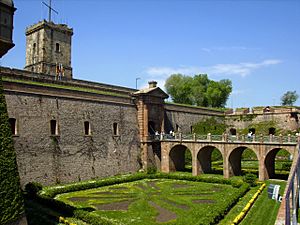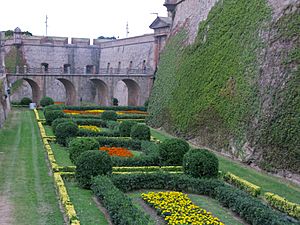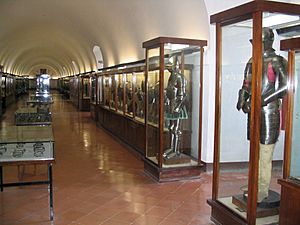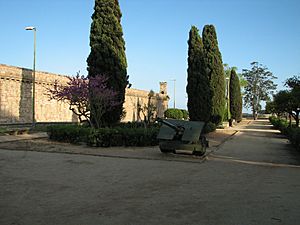Montjuïc Castle facts for kids

Montjuïc Castle (Catalan: Castell de Montjuïc, Spanish: Castillo de Montjuich) is an old military fortress located on top of Montjuïc hill in Barcelona, Catalonia, Spain. It was first built in 1640 and has played a big part in Barcelona's history. Today, it's a special place managed by the city of Barcelona.
Contents
The Castle's Story: A Look Back
The very first stone for this important fort was laid in 1640. Just one year later, in January 1641, the fort saw its first battle. This happened during the Reapers' War, when the region of Catalonia challenged the King of Spain's power.
The King of Spain sent a large army to stop the revolt. They won back some cities, but they were defeated at the Battle of Montjuïc. Catalan forces, led by Francesc de Tamarit, won this battle. Sadly, Colonel Shane O'Neill, also known as Prince Juan O'Neill, died leading his soldiers. He was honored by the King of Spain with the title Viscount Montjuïc.
Becoming a Stronger Castle
About 50 years later, in 1694, new strong walls and towers, called bastions and battlements, were added. This made the fort much stronger and it officially became a castle. In 1705, during the Siege of Barcelona (1705), British soldiers captured the fortress. This helped them take control of Barcelona itself.
An amazing engineer named Giovanni Antonio Medrano drew up new plans for the castle in 1730. Based on these plans, the old fort was taken down in 1751. A Spanish engineer, Juan Martin Cermeño, then built the castle we see today. Between 1779 and 1799, even more work was done to make the castle better. It was also given 120 cannons to defend itself.
Montjuïc During Wars
During the Napoleonic Wars, the French Army entered Barcelona. On orders from Napoleon, they took control of the castle without a fight. The soldiers guarding the castle were told not to resist.
Over the last 350 years, Montjuïc Castle has been very important in Barcelona's history. It became a symbol after Catalonia's defeat in 1714. In the late 1800s, the castle was known as a place where people were held captive during difficult times.
The castle also played a sad role during the Spanish Civil War (1936-1939). In 1940, Lluís Companys, who was the president of the Generalitat of Catalonia (the government of Catalonia) during the war, sadly lost his life at Montjuïc Castle.
Later in the 20th century, the castle became a military museum. In June 1963, Francisco Franco opened the Military Armor Museum there.
Montjuïc Castle Today
In April 2007, the Spanish government gave the castle to the Barcelona City Council. After many talks, the castle became a public place for everyone to enjoy. In 2010, the museum closed, and the City Council began working to restore parts of the castle, like its roof and a watchtower.
Today, there are exciting plans for the castle. These include L’Espai de la Memòria (a space for memory), El Centre d’Interpretació de la Muntanya de Montjuïc (a center to learn about Montjuïc mountain), and various cultural activities.
How to Visit the Castle
It's easy to get to Montjuïc Castle! You can take the Montjuïc cable car, which is like a small cabin that carries you up the mountain. Its top station is very close to the castle entrance. You can also take the Montjuïc funicular, a special train that goes up the mountain from the Paral·lel station of the Barcelona Metro. This funicular connects to the lower station of the cable car. Another fun way to arrive is by the Port Vell Aerial Tramway from Port Vell, Barcelona's old harbor.
See also
 In Spanish: Castillo de Montjuic para niños
In Spanish: Castillo de Montjuic para niños




